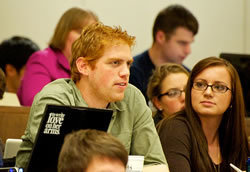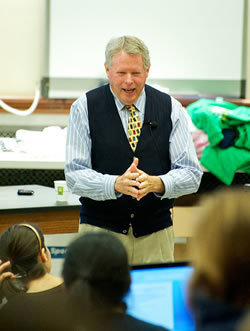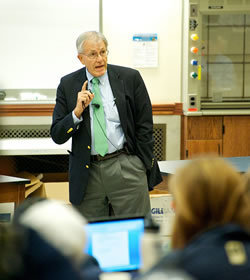
A one–day course on Scientific and Medical Leadership, organized by Dean Gregory Crawford, brought top scientists, entrepreneurs, physicians, and academic, military, business and innovation leaders to address a large lecture room filled with undergraduates in the Jordan Hall of Science. The 10–hour event, with nine presentations followed by discussion, was held Oct. 1. Crawford said the leadership course, like a one–day ethics course offered last year, is part of an increased focus on practical opportunities in science.

Presenters were Norbert Wiech, president of Lysomics, LLC; Jack Dixon, Vice President and Chief Science Officer of the Howard Hughes Medical Institute; Albert Gutierrez, President and CEO of St. Joseph Regional Medical Center in Mishawaka, Ind.; Dr. George Bosl, Chair of the Department of Medicine at Memorial Sloan-Kettering Cancer Center; Christine Maziar, Vice President and Senior Assistant Provost at Notre Dame; Matthew Krathwohl, Executive Director and Lead Faculty of the Pfeil Innovation Center in South Bend; Capt. Clarence Earl Carter, Commanding Officer of Naval ROTC and Professor of Naval Science at Notre Dame; Robert Boguslaski, President of Serim Research Corp. in Elkhart; and George Keegan, Senior Director of Corporate and Foundation Relations at Notre Dame.

Many of the leaders focused on common elements of leadership — learning from mentors and mentoring others in turn; assembling an expert team and delegating responsibilities; leading by example with a clear vision; and taking a realistic approach to both problems and opportunities. Common themes emerged among the high–tech leaders, science–based entrepreneurs, academics and Capt. Carter's experience as a Navy submarine commander. Wiech, a successful entrepreneur in the drug development field, said good science is necessary but not sufficient for starting a business and urged would–be entrepreneurs to focus on an execution plan.

Gutierrez, whose faith-based institution has been recognized as a Most Wired Hospital, said leaders must inspire as well as inform when they set expectations, and he described the leader's role when science and emotions intersect. Dixon said the Hughes Foundation invests in people, not projects, in search of high–risk, high–reward breakthrough discoveries. Bosl described how he maintained his personal and professional principles as his career has evolved, with administrative responsibilities taking more time from patient care because the job provided opportunities to multiply the number of people providing such care. Keegan, who won an Emmy for a television series on Thomas Edison, closed the event with a case study on Edison's leadership style.

"The students had a wonderful opportunity to learn from a lineup of highly accomplished and respected leaders which might take them years to meet in their careers," Crawford said, adding that most of the presenters have Notre Dame connections that helped make quick connections to the undergraduates. "In one day, they were able not only to hear these experts' ideas and experiences, but they had the chance to ask questions and to interact with them one–on–one at breaks. It was gratifying to see how many were eager to take advantage of the opportunity."